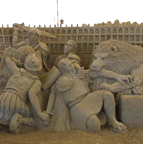 "I stumbled across this website and was amazed at the beauty of these sand sculptures depicting images of the Roman Empire. The city of Jesolo, Italy sponsors this sand sculpture competition each year with a different theme. I heartily approve of this year’s subject!
"I stumbled across this website and was amazed at the beauty of these sand sculptures depicting images of the Roman Empire. The city of Jesolo, Italy sponsors this sand sculpture competition each year with a different theme. I heartily approve of this year’s subject!
Subsection of Roman Times:
Articles about current archaeology and research into the remains of Roman and Byzantine civilizations.
Friday, October 31, 2003
The Roman Empires Rises Again In Sand
 "I stumbled across this website and was amazed at the beauty of these sand sculptures depicting images of the Roman Empire. The city of Jesolo, Italy sponsors this sand sculpture competition each year with a different theme. I heartily approve of this year’s subject!
"I stumbled across this website and was amazed at the beauty of these sand sculptures depicting images of the Roman Empire. The city of Jesolo, Italy sponsors this sand sculpture competition each year with a different theme. I heartily approve of this year’s subject!
Rome's sea route reopens after 200 years
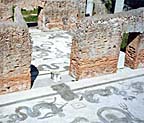 "Riverboats will return to ancient Rome's sea route for the first time in 200 years next week, giving tourists a view from the Tiber river to rival any of the Eternal City's attractions on dry land. The boats will ply a disused route along the green-tinged river from the edge of the city centre to the mosaic-filled ruins of Ostia Antica -- a two-hour trip away from the whizz of scooters and the pilgrims at St Peter's Square in the Vatican."
"Riverboats will return to ancient Rome's sea route for the first time in 200 years next week, giving tourists a view from the Tiber river to rival any of the Eternal City's attractions on dry land. The boats will ply a disused route along the green-tinged river from the edge of the city centre to the mosaic-filled ruins of Ostia Antica -- a two-hour trip away from the whizz of scooters and the pilgrims at St Peter's Square in the Vatican."
"It was the greatest gateway to Rome," said Anna Gallina Zevi, chief archaeologist of the sixth century ruins during the inaugural sail late on Saturday.
"Wines, olives, marble for St Peter's, salt from the coast, ceramics from all over the Mediterranean... plundered obelisks from Africa, elephants for the games at the Colosseum all came up the river."
Thursday, October 30, 2003
Successful Roman Festival Sparks Call For Community Dig
MIDDLEWICH Roman Festival has proved to be such a success that the town has developed a vision for a museum and a 'community dig' to retrieve archeological items. Town clerk Jonathan Williams has teamed up with archeologist Tim Strickland to bid for a grant of almost £50,000 from the Heritage Lottery Fund. They are hoping that a grant would enable them to carry out further research on Roman Middlewich and look at the potential for a museum.
"The grant money could also help to fund a community dig", said Williams, "as this would be a great way to get people involved in searching for Roman artefacts that could eventually be displayed for the whole town to see."
"The grant money could also help to fund a community dig", said Williams, "as this would be a great way to get people involved in searching for Roman artefacts that could eventually be displayed for the whole town to see."
Monday, October 27, 2003
Earliest Private Chapel in Roman Villa Unearthed
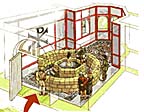 "The earliest private chapel from Dark Age Britain has been unearthed in the foundations of a Roman 'stately home'.
"The earliest private chapel from Dark Age Britain has been unearthed in the foundations of a Roman 'stately home'.
The fifth century font and baptistry were built into the ornate mosaic floor of an unusual double villa in Wiltshire not long after the Romans left Britain.
Although there are older chapels, archaeologists say it is the earliest example of a landowner converting rooms inside his home for baptisms."
Verulamium Saved From The Plough
 "Verulamium, a site treasured by archaeologists for years as a unique monument to Roman Britain, is now safe from destruction by the plough, thanks to an important agreement between English Heritage and the local landowner. The agreement, announced on October 22, will ensure that fields covering part of one of the country’s most important archaeological sites, near St.Albans, are taken permanently out of cultivation and converted to permanent pasture. Ancient hedgerows that had been removed to facilitate cultivation will be re-instated. "
"Verulamium, a site treasured by archaeologists for years as a unique monument to Roman Britain, is now safe from destruction by the plough, thanks to an important agreement between English Heritage and the local landowner. The agreement, announced on October 22, will ensure that fields covering part of one of the country’s most important archaeological sites, near St.Albans, are taken permanently out of cultivation and converted to permanent pasture. Ancient hedgerows that had been removed to facilitate cultivation will be re-instated. "
Founded about AD 49, a few years after the Claudian invasion of Britain, Verulamium has been key to our understanding of Roman civilisation and urban development in the Empire. Eventually covering about 200 acres, the town had a full range of public buildings, including a temple, forum, theatre and amphitheatre. More than 30 mosaics have been found.
Wednesday, October 22, 2003
Large 1st Century Roman Bath House Found In Nazareth
"Professor Richard Freund, of the Maurice Greenberg Centre for Judaic Studies at Hartford University in Connecticut, says the discovery means that historians will have to rethink the place and significance of Nazareth in the Roman empire and consequently the formative experiences of Jesus. It has been assumed that the Nazareth of 2,000 years ago was a poor Jewish village on the periphery of the empire, where local families inhabited caves on the hillside that today contains the modern Israeli-Arab city. On this view, the young Jesus would have had little contact with the Romans until he left Nazareth as an adult; his father, Joseph, one of many craftsmen in the town, may have worked on a Roman palace at nearby Sephori.
But the huge scale of Shama's bathhouse suggests that Nazareth, rather than Sephori, was the local hub of military control from Rome. The giant bath could only have been built for a Roman city or to service a significant garrison town. That would mean Joseph and Mary, and their son Jesus, would have been living in the very heart of the occupying power. This is likely to have huge significance for New Testament scholars in their understanding of Jesus's later teachings. "
But the huge scale of Shama's bathhouse suggests that Nazareth, rather than Sephori, was the local hub of military control from Rome. The giant bath could only have been built for a Roman city or to service a significant garrison town. That would mean Joseph and Mary, and their son Jesus, would have been living in the very heart of the occupying power. This is likely to have huge significance for New Testament scholars in their understanding of Jesus's later teachings. "
Row-powered Roman Cargo Barges Discovered
 "Dutch archaeologists have discovered a Roman cargo ship equipped with oars, a unique find that explains how imperial Rome defended itself on its northern frontiers.
"Dutch archaeologists have discovered a Roman cargo ship equipped with oars, a unique find that explains how imperial Rome defended itself on its northern frontiers.
The barge, dating from around 100AD, was excavated in the Dutch town of Woerden, which was once the location of the Roman military settlement Castellum Laurium on the banks of the Rhine.
The flat-bottomed boat was manned by at least 12 rowers. The oars would have allowed the Romans to navigate strong currents back to the German Eiffel region from where it had brought rocks to strengthen the forts along the frontier. "
Dogs In The Roman Empire
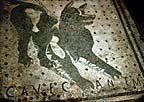 "The Roman empire became a melting pot of dogs from all its conquests. As in ancient Egypt, Roman dogs served in a variety of roles, from companions and guard dogs to vicious fighting dogs pitted against slaves and wild animals.
"The Roman empire became a melting pot of dogs from all its conquests. As in ancient Egypt, Roman dogs served in a variety of roles, from companions and guard dogs to vicious fighting dogs pitted against slaves and wild animals.
The proverbial “dogs of war” were also Roman. Huge and fearsome Molossians, which resembled giant Rottweilers, were sent into battle to kill and dismember the enemy.
Mollosian, now extinct, originally came from Greece, where they were also used for fighting. Alexander the Great owned a Mollosian named Peritas who, legend has it, killed a lion and an elephant in fighting matches.
Roman citizens sometimes had Mollosian guard dogs. In Pompeii, archaeologists have found mosaics depicting Mollosians outside people’s homes with the message cave canem – “beware of the dog”."
Tuesday, October 21, 2003
Legions in German Frontier Entertained in Theater
"Archaeologists have discovered the remains of a Roman theatre in the small German town of Kuenzing, suggesting that soldiers at the front were entertained by gladiators and animal fights.
Known as Quintanis in Roman times, the town was on the Danube frontier of the Roman empire and garrisoned by 500 mercenaries."
Known as Quintanis in Roman times, the town was on the Danube frontier of the Roman empire and garrisoned by 500 mercenaries."
Tuesday, October 14, 2003
Tombs Reveal Ancient Culture in Po Valley
 Dating between 1500 and 1200 B.C., a necropolis consisting of more than 2,000 tombs belonging to the people of the "terramare" — prehistoric flat-topped mounds left by a Bronze Age pile-dwelling settlement built on dry land, are being excavated near Modena, Italy.
Dating between 1500 and 1200 B.C., a necropolis consisting of more than 2,000 tombs belonging to the people of the "terramare" — prehistoric flat-topped mounds left by a Bronze Age pile-dwelling settlement built on dry land, are being excavated near Modena, Italy.
"It is interesting that the tombs did not contain arms [weapons] but only female objects, mainly bronze items such as brooches and pendants. We found arms gathered in another area of the cemetery. They had been burned and broken, probably in a funerary ritual," project director Andrea Cardarelli, professor of prehistory and proto-history at Modena University said.
Despite the precariously preserved cremated bones, Cardarelli has begun an anthropological study which in the following months should reveal not only the sex and age of the buried people but — thanks to specific chemical signals (isotopic values) in bones — their diet.
Remains Of Woman Warrior Found
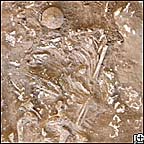 "Remains Of Xena-Like Woman Found: "The remains of a six-foot tall woman, buried with a shield and knife, were recently discovered in an Anglo-Saxon cemetery in Lincolnshire, England.
"Remains Of Xena-Like Woman Found: "The remains of a six-foot tall woman, buried with a shield and knife, were recently discovered in an Anglo-Saxon cemetery in Lincolnshire, England.
The body and artifacts, which date to A.D. 500-600, suggest that more women than previously believed may have fought alongside men during the turbulent years following England's Roman period. "
"...the shield had been placed on top of the woman before burial. The knife rested alongside her unusually tall body. Even most men at the time measured several inches shorter.
"Another unusual aspect of the burial was that the feminine jewelry and clothing accessories normally found in women's graves from this period were not present. Instead, her feet were bound with rope, and the only adornment was an amber necklace draped around her neck."
"In addition to the shields, remains of two other individuals — a man and another woman — were unearthed. None of the individuals appears to have been related or otherwise connected to one another. The second woman was of average height and wore the wrist clasps, girdle hangers, and little pieces of bronze jewelry more commonly found in female graves of the time."
Roman baths threatened by water
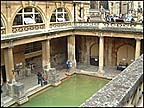 "Emergency work is under way in Somerset after water leaks at Roman baths were found to be destroying an artefact more than 1,700 years old. Stephen Clews, curator of the Roman baths, said: "It may seem odd that water should be a problem for a bath.
"Emergency work is under way in Somerset after water leaks at Roman baths were found to be destroying an artefact more than 1,700 years old. Stephen Clews, curator of the Roman baths, said: "It may seem odd that water should be a problem for a bath.
"But what is happening is a cycle of wetting and drying has developed as the condition of the road above deteriorates and leaks form.
"Over time salt in the water causes problems with the structure of the ancient stonework and Roman renders," he added.
Friday, October 10, 2003
Enameled Roman vessel found in Staffordshire Hills
 Although this item was posted in January, it only now came to my attention and I admired the artistry of the piece.
Although this item was posted in January, it only now came to my attention and I admired the artistry of the piece.
An exquisite bronze pan found in the Staffordshire Hills has drawn the attention of experts because it is decorated with Celtic motifs and features an engraved inscription just below the rim.
"It lists the four forts at the western end of Hadrian's Wall in sequence: Mais (Bowness), Coggabata (Drumburgh), Uxelodunum (Stanwix), and Cammoglanna (Castlesteads).
It also carries a Greek name - 'Aelius Draco'. "
"Sally Worrell, of the Portable Antiquities Scheme, said: "Aelius Draco was perhaps a veteran of a garrison of Hadrian's Wall and, on retirement, had this pan made to recall his time in the army. His name suggests that he or his family originated in the Greek-speaking part of the eastern Roman Empire."
The pan was probably used like a saucepan.
Monday, October 06, 2003
Layers Of Pompeii Dating Back to 3rd Century BC Unearthed
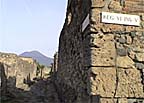 ""After three years of research, the Pompeii that Mount Vesuvius did not bury is coming to light, according to Italian archaeologists.
""After three years of research, the Pompeii that Mount Vesuvius did not bury is coming to light, according to Italian archaeologists.
Hidden in layers beneath the town overwhelmed by lava and ash by the most famous eruption in history, the ancient settlement dates back to the third century B.C. "
"With his colleague Filippo Coarelli of Perugia University, Pesando investigated a series of houses in the Regio VI quarter in the northern area of the town, which carried several of those unusual architectural features. "
The town that is coming to light is slightly different. It was characterized by steps and narrow streets accessible only with donkeys, while row of smaller houses lined larger streets."
"Pompeii was built on steps degrading toward [the] south. This is one of the reasons why the site was originally chosen to build a settlement. Given the town's position, rain water would have flowed down preventing floods," Pesando said."
"In the following century, Pompeii slowly turned into the city that visitors admire today. The steps disappeared and new houses were built on top of the old ones, making the town more even and regular. "
Roman building found on site of new RAF baseball field
Archaeologists digging where the RAF base Mildenhall plans to build a new baseball field have found cattle and human bones from the Iron Age, and coins, brooches and human bones from the Roman era.
The dig has unearthed a Roman building more than 30 feet wide and a body from the late Iron Age or early Roman era buried on its face. A couple bodies have yet to be excavated. One is in a wooden casket, meaning it is certainly Roman.
The dig has unearthed a Roman building more than 30 feet wide and a body from the late Iron Age or early Roman era buried on its face. A couple bodies have yet to be excavated. One is in a wooden casket, meaning it is certainly Roman.
Wednesday, October 01, 2003
Ancient Roman church discovered in Turkey
"A church from the era of the ancient Roman Empire (late period) was discovered in the district of Golhisar, in the city of Burdur when a villager from Yusufca stumbled across painted frescos. The director of Burdur Museum Haci Ali Ekinci announced that restoration of this ancient church will begin next year."
New Method Developed For Dating Archaeological Pottery
Researchers at Britain's University of Bristol have developed the first direct method for dating pottery by examining animal fats preserved inside the ceramic walls.
Pottery is essential for classifying archaeological sites. Organic materials, such as wood and bone, can easily be dated using radiocarbon techniques, but they aren't always available or reliable. Wood tends to decompose over time, and animals often dig up bones and move them around a site. Ceramics, however, have a long and stable lifespan.
"If you go to a site and you find large amounts of Roman pottery, then you know you've got a Roman site," says Richard Evershed, Ph.D., a chemist at the University of Bristol and lead author of the paper. "Later pottery, such as Roman, is relatively easy to date from its appearance, but earlier pottery can be much harder because of its rough and ready appearance. That's where the appeal of having a technique like this comes in."
Pottery is essential for classifying archaeological sites. Organic materials, such as wood and bone, can easily be dated using radiocarbon techniques, but they aren't always available or reliable. Wood tends to decompose over time, and animals often dig up bones and move them around a site. Ceramics, however, have a long and stable lifespan.
"If you go to a site and you find large amounts of Roman pottery, then you know you've got a Roman site," says Richard Evershed, Ph.D., a chemist at the University of Bristol and lead author of the paper. "Later pottery, such as Roman, is relatively easy to date from its appearance, but earlier pottery can be much harder because of its rough and ready appearance. That's where the appeal of having a technique like this comes in."
Subscribe to:
Comments (Atom)